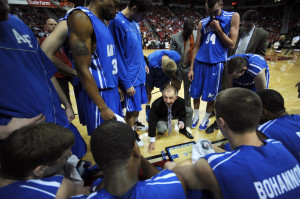Using a Coaching Board
A Coaching Board is a valuable tool in communicating specific tactical information to players. In the right hands, a coaching board can be very helpful in simplifying complex movements on the court. In the wrong hands, however a coaching board can confuse and overload players with information that hinders performance and causes frustration. The difference between the two is very fine line.

A coaching board is used to diagram tactical movements, these can be either offensive or defensive, your teams or the oppositions. However, the board can also be used as a way of displaying information such as names and numbers for defensive match-ups or points of emphasis for the start of a game. There are a number of ways to communicate information using a coaching board and as a coach, you should experiment using these throughout a game and training session situations.
One of the simplest ways to help in the communication process is to select a coaching board that is versatile. Not all coaching boards are created equal, there are some that include multiple lay-outs of a basketball court such as half court and full court. Try to select one that has a mixture of diagrams so there are options to choose from to best fit the situation and the need at the time.
Another very simple point to be aware of when using a coaching board is that different coloured whiteboard pens will be easier read then others depending on the colour of the coaching board itself. Typically, black, blue and purple colours tend to be the most distinctive and offer the best contrast from the lighter background of a coaching board. Colours such as red or green will be more difficult to see for players and as a result make the intend message less effective.
A common problem often encountered when using a coaching board is the diagram descending into chaos because of the number of movements depicted. Try to be very succinct in your communication and subsequent diagraming. If discussing a complicated pattern or scenario, try to focus on the key movements involved and then verbalise everything, but only diagram the important or crucial section to help with player retention. It also helps when diagramming to speak to specific players about each of the movements they will be involved in. Try making eye content with each player and using their name when discussing their involvement in the diagram.
A great benefit of using a coaching board is that during games there are always situations that require some tweaking of a team’s tactics and strategy in general. These change-ups might not have always been foreseen in training sessions, so need to be discussed and implemented on the run. A coaching board can help with discussing what these changes are and how they need to be implemented during breaks in play or time-outs. Just remember to make sure to limit the amount of information you are trying to communicate all at once.
A coaching board is one of many tools a coach can use. Because it is one of the simplest tools to use though the technique of being able to use a coaching board efficiently and effectively is often overlooked. Like all aspects of coaching, there is the opportunity to always improve and refine our knowledge and skills and using a coaching board is no exception.







Leave a Reply